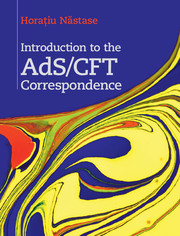Introduction
Published online by Cambridge University Press: 05 September 2015
Summary
This book gives an introduction to the Anti-de Sitter/Conformal Field Theory correspondence, or AdS/CFT, so it would be useful to first understand what it is about.
From the name, we see that it is a relation between a quantum field theory with conformal invariance (which is a generalization of scaling invariance), living in our flat 4-dimensional space, and string theory, which is a quantum theory of gravity and other fields, living in the background solution of AdS5 × S5 (5-dimensional Anti-de Sitter space times a 5-sphere), a curved space with the property that a light signal sent to infinity comes back in a finite time.
The flat 4-dimensional space containing the field theory lives at the boundary (situated at infinity) of the AdS5 × S5, thus the correspondence, or equivalence, is said to be an example of holography, since it is similar to the way a 2-dimensional hologram encodes the information about a 3-dimensional object. The background AdS5 ×S5 solution is itself a solution of string theory, as the relevant theory of quantum gravity.
From this description, it is obvious that before we describe AdS/CFT, we must first introduce a number of topics, which is done in Part I of the book. First, we review some relevant notions of quantum field theory, though I assume that the reader has a working knowledge of quantum field theory. Then I describe some basic concepts of general relativity, supersymmetry, and supergravity, since string theory is a supersymmetric theory, whose low energy limit is supergravity. After that, I introduce black holes and p-branes, since the AdS5 × S5 string theory background appears as a limit of them. Finally, I introduce string theory, elements of conformal field theory (4-dimensional flat space theories with conformal invariance), and D-branes, which are objects in string theory on which the relevant quantum field theories can be defined.
The AdS/CFT correspondence was put forward by Juan Maldacena in 1997, as a conjectured duality based on a heuristic derivation which will be explained, and until now there is no exact proof for it. However, there is an enormous amount of evidence in its favor in the form of calculations matching on the two sides of the correspondence, turning it into a virtual certainty, so while technically we should append the name “conjecture” to it, this would be a pedantic point, and I shall refrain from doing so.
- Type
- Chapter
- Information
- Introduction to the AdS/CFT Correspondence , pp. xvii - xviiiPublisher: Cambridge University PressPrint publication year: 2015

